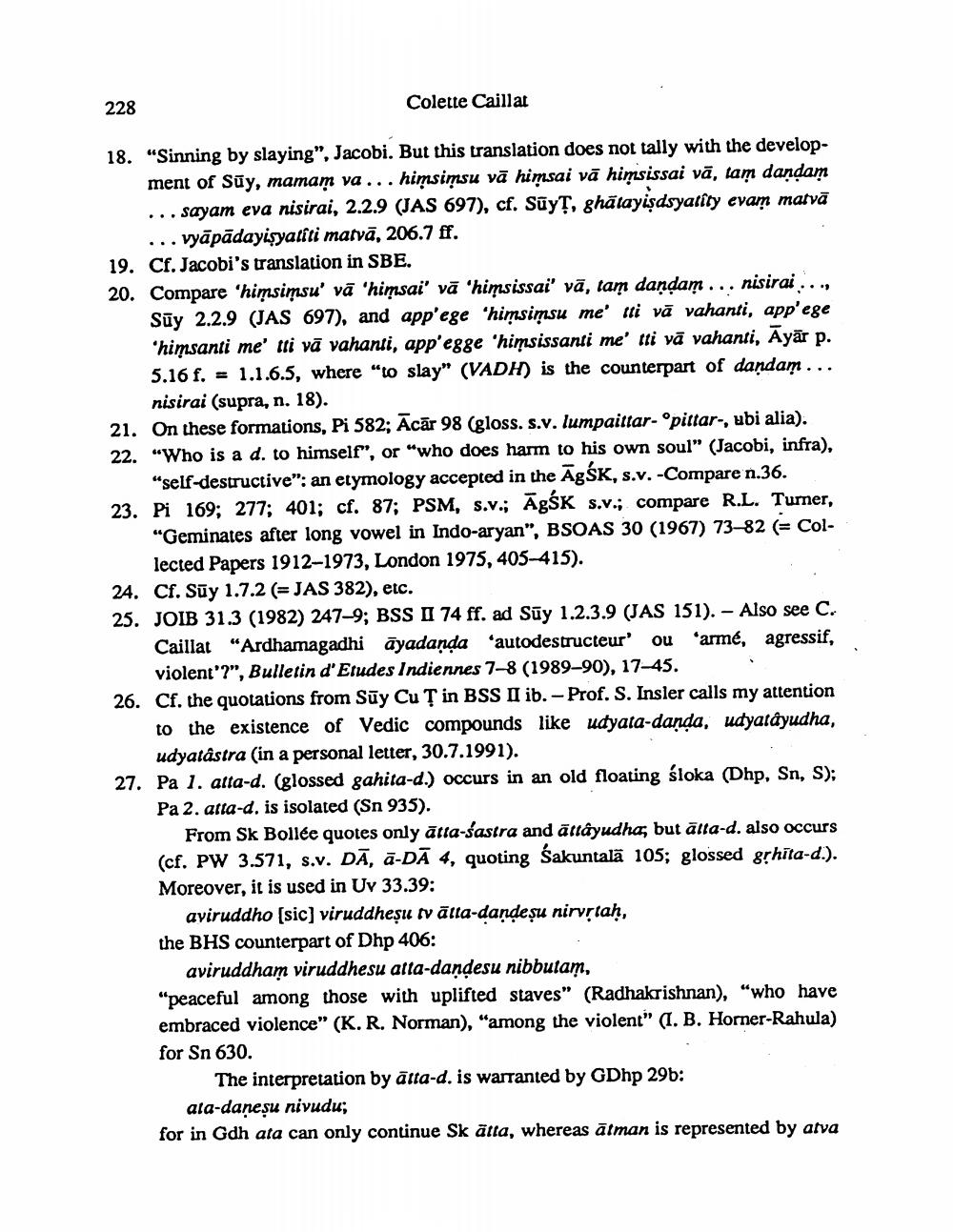________________
228
Colette Caillat
18. "Sinning by slaying", Jacobi. But this translation does not tally with the develop
ment of Sūy, mamam va ... hiņsimsu vā himsai vā himsissai vā, tam dandam ... sayam eva nisirai, 2.2.9 (JAS 697), cf. Sūys, ghātayişdsyatîty evam matvā
... vyāpādayişyatîti matvā, 206.7 ff. 19. Cf. Jacobi's translation in SBE. 20. Compare 'himsimsu' vā 'himsai' vā 'himsissai' vā, tam dandam ... nisirai ...,
Sūy 2.2.9 (JAS 697), and app'ege 'himsiņsu me' iti vā vahanti, app'ege "himsanti me' tti vā vahanti, app'egge 'himsissanti me' tti vā vahanti, Ayär p. 5.16 f. = 1.1.6.5, where "to slay" (VADH) is the counterpart of dandam...
nisirai (supra, n. 18). 21. On these formations, Pi 582; Ācār 98 (gloss. s.v. lumpaittar- opittar., ubi alia). 22. “Who is a d. to himself", or "who does harm to his own soul" (Jacobi, infra),
"self-destructive": an etymology accepted in the ĀgśK, s.v. -Compare n.36. 23. Pi 169; 277; 401; cf. 87; PSM, s.v.; ĀgśK s.v.; compare R.L. Turner,
"Geminates after long vowel in Indo-aryan", BSOAS 30 (1967) 73-82 (= Col
lected Papers 1912–1973, London 1975, 405-415). 24. Cf. Sūy 1.7.2 (= JAS 382), etc. 25. JOIB 31.3 (1982) 247-9; BSS [ 74 ff. ad Sūy 1.2.3.9 (JAS 151). - Also see C.
Caillat "Ardhamagadhi āyadanda 'autodestructeur' ou 'armé, agressif,
violent'?", Bulletin d'Etudes Indiennes 7–8 (1989–90), 17-45. 26. Cf. the quotations from Sūy CuȚ in BSS II ib.-Prof. S. Insler calls my attention
to the existence of Vedic compounds like udyata-danda, udyatayudha,
udyatâstra (in a personal letter, 30.7.1991). 27. Pa 1. atta-d. (glossed gahita-d.) occurs in an old floating sloka (Dhp, Sn, S);
Pa 2. atta-d. is isolated (Sn 935).
From Sk Bollée quotes only ātta-sastra and āttayudha, but älta-d. also occurs (cf. PW 3.571, s.v. DĀ, ā-DĀ 4, quoting Sakuntalā 105; glossed grhīta-d.). Moreover, it is used in Uv 33.39:
aviruddho (sic) viruddheșu tv ätta-dandeșu nirvrtaḥ, the BHS counterpart of Dhp 406:
aviruddham viruddhesu atta-dandesu nibbutam, "peaceful among those with uplifted staves" (Radhakrishnan), "who have embraced violence" (K. R. Norman), "among the violent" (1. B. Horner-Rahula) for Sn 630.
The interpretation by ātta-d. is warranted by GDhp 29b: ata-daneșu nivudu; for in Gdh ata can only continue Sk ātta, whereas ātman is represented by atva




